Questões Militares
Foram encontradas 12.287 questões
Resolva questões gratuitamente!
Junte-se a mais de 4 milhões de concurseiros!

Rick Jervis, September 24, 2015
SANTIAGO DE CUBA – I've always been fairly skeptical about how much power one man can exercise, even if that man commands the attention of 1.2 billion Roman Catholics.
I understand that Pope John Paul II visited Poland in the 1970s and '80s and gave speeches so stirring that they helped launch the Solidarity opposition movement and lead to the collapse of communism in the country. And I know that popes throughout history have had influential moments.
But, really, how much can one man and one microphone do? How literally do people take his message? These were the questions that kept my mind busy when I left for Cuba last week to cover Pope Francis' four-day trip. I was curious to see how much impact the words of this 78-year-old man can have on a population of 11 million.
I'm becoming fairly familiar with Cuba. I've been to the island three times this year, five times overall, and grew up in southern Florida. My parents are Cubans who left the country in 1962. Cuba today continues to fascinate and dismay. It's a place of beauty and jolting contradictions. The re-establishment of relations between the U.S. and Cuban governments, begun last December, continue to stir excitement and hope in Cubans, and changes are trickling in.
I followed Pope Francis from Havana to Santiago and heard him talk of reconciliation, love for mankind and the importance of family. I interviewed Cubans who glowed with the fervor of the faithful as they pledged their love for the Pope and promised to follow his message. But my question remained: What does all of this mean? How does it translate to actual change on the island?
To help me sort through this, I visited Father Jorge Catasus, a popular parish priest here who helped welcome the Pope to the city. We sat in the cool, cavernous back room of his 18th-century church, safe from the 37-degree heat outside. Catasus said “don't focus on any grand political or social changes stemming from the papal visit". The most important changes, he said, come from within. That's what Pope Francis offered as a first step, and that's what Cubans across the island, in chants, cheers and tearful acceptance, agreed to abide by.
“The lives of men are decided in their hearts", Catasus told me. “That's where we'll see the change". This may not be 1980s Poland, and Solidarity may still not be anywhere in sight. But first things first. A change of heart can often lead to a world of good.

Rick Jervis, September 24, 2015
SANTIAGO DE CUBA – I've always been fairly skeptical about how much power one man can exercise, even if that man commands the attention of 1.2 billion Roman Catholics.
I understand that Pope John Paul II visited Poland in the 1970s and '80s and gave speeches so stirring that they helped launch the Solidarity opposition movement and lead to the collapse of communism in the country. And I know that popes throughout history have had influential moments.
But, really, how much can one man and one microphone do? How literally do people take his message? These were the questions that kept my mind busy when I left for Cuba last week to cover Pope Francis' four-day trip. I was curious to see how much impact the words of this 78-year-old man can have on a population of 11 million.
I'm becoming fairly familiar with Cuba. I've been to the island three times this year, five times overall, and grew up in southern Florida. My parents are Cubans who left the country in 1962. Cuba today continues to fascinate and dismay. It's a place of beauty and jolting contradictions. The re-establishment of relations between the U.S. and Cuban governments, begun last December, continue to stir excitement and hope in Cubans, and changes are trickling in.
I followed Pope Francis from Havana to Santiago and heard him talk of reconciliation, love for mankind and the importance of family. I interviewed Cubans who glowed with the fervor of the faithful as they pledged their love for the Pope and promised to follow his message. But my question remained: What does all of this mean? How does it translate to actual change on the island?
To help me sort through this, I visited Father Jorge Catasus, a popular parish priest here who helped welcome the Pope to the city. We sat in the cool, cavernous back room of his 18th-century church, safe from the 37-degree heat outside. Catasus said “don't focus on any grand political or social changes stemming from the papal visit". The most important changes, he said, come from within. That's what Pope Francis offered as a first step, and that's what Cubans across the island, in chants, cheers and tearful acceptance, agreed to abide by.
“The lives of men are decided in their hearts", Catasus told me. “That's where we'll see the change". This may not be 1980s Poland, and Solidarity may still not be anywhere in sight. But first things first. A change of heart can often lead to a world of good.

Rick Jervis, September 24, 2015
SANTIAGO DE CUBA – I've always been fairly skeptical about how much power one man can exercise, even if that man commands the attention of 1.2 billion Roman Catholics.
I understand that Pope John Paul II visited Poland in the 1970s and '80s and gave speeches so stirring that they helped launch the Solidarity opposition movement and lead to the collapse of communism in the country. And I know that popes throughout history have had influential moments.
But, really, how much can one man and one microphone do? How literally do people take his message? These were the questions that kept my mind busy when I left for Cuba last week to cover Pope Francis' four-day trip. I was curious to see how much impact the words of this 78-year-old man can have on a population of 11 million.
I'm becoming fairly familiar with Cuba. I've been to the island three times this year, five times overall, and grew up in southern Florida. My parents are Cubans who left the country in 1962. Cuba today continues to fascinate and dismay. It's a place of beauty and jolting contradictions. The re-establishment of relations between the U.S. and Cuban governments, begun last December, continue to stir excitement and hope in Cubans, and changes are trickling in.
I followed Pope Francis from Havana to Santiago and heard him talk of reconciliation, love for mankind and the importance of family. I interviewed Cubans who glowed with the fervor of the faithful as they pledged their love for the Pope and promised to follow his message. But my question remained: What does all of this mean? How does it translate to actual change on the island?
To help me sort through this, I visited Father Jorge Catasus, a popular parish priest here who helped welcome the Pope to the city. We sat in the cool, cavernous back room of his 18th-century church, safe from the 37-degree heat outside. Catasus said “don't focus on any grand political or social changes stemming from the papal visit". The most important changes, he said, come from within. That's what Pope Francis offered as a first step, and that's what Cubans across the island, in chants, cheers and tearful acceptance, agreed to abide by.
“The lives of men are decided in their hearts", Catasus told me. “That's where we'll see the change". This may not be 1980s Poland, and Solidarity may still not be anywhere in sight. But first things first. A change of heart can often lead to a world of good.
1. He visited a priest who also gave speeches during the Pope's stay in Cuba.
2. He talked to the Cuban people and observed their faith.
3. In order to escape from the warm weather, he decided to go to an old church.
4. He followed Pope Francis and heard his speeches.
Which of the statements above are TRUE, according to the text?

Rick Jervis, September 24, 2015
SANTIAGO DE CUBA – I've always been fairly skeptical about how much power one man can exercise, even if that man commands the attention of 1.2 billion Roman Catholics.
I understand that Pope John Paul II visited Poland in the 1970s and '80s and gave speeches so stirring that they helped launch the Solidarity opposition movement and lead to the collapse of communism in the country. And I know that popes throughout history have had influential moments.
But, really, how much can one man and one microphone do? How literally do people take his message? These were the questions that kept my mind busy when I left for Cuba last week to cover Pope Francis' four-day trip. I was curious to see how much impact the words of this 78-year-old man can have on a population of 11 million.
I'm becoming fairly familiar with Cuba. I've been to the island three times this year, five times overall, and grew up in southern Florida. My parents are Cubans who left the country in 1962. Cuba today continues to fascinate and dismay. It's a place of beauty and jolting contradictions. The re-establishment of relations between the U.S. and Cuban governments, begun last December, continue to stir excitement and hope in Cubans, and changes are trickling in.
I followed Pope Francis from Havana to Santiago and heard him talk of reconciliation, love for mankind and the importance of family. I interviewed Cubans who glowed with the fervor of the faithful as they pledged their love for the Pope and promised to follow his message. But my question remained: What does all of this mean? How does it translate to actual change on the island?
To help me sort through this, I visited Father Jorge Catasus, a popular parish priest here who helped welcome the Pope to the city. We sat in the cool, cavernous back room of his 18th-century church, safe from the 37-degree heat outside. Catasus said “don't focus on any grand political or social changes stemming from the papal visit". The most important changes, he said, come from within. That's what Pope Francis offered as a first step, and that's what Cubans across the island, in chants, cheers and tearful acceptance, agreed to abide by.
“The lives of men are decided in their hearts", Catasus told me. “That's where we'll see the change". This may not be 1980s Poland, and Solidarity may still not be anywhere in sight. But first things first. A change of heart can often lead to a world of good.
( ) He was raised in the south of Florida, USA.
( ) His parents are Cubans who left the country and moved to the USA.
( ) He feels fascinated by the beauty and contradictions of Cuba.
( ) He considers that Cubans are not interested about the re-establishment of relations with the USA.
( ) He was born in 1962 when his parents left Cuba.
Mark the alternative which presents the correct sequence, from top to bottom.
By Menchie Mendoza, Tech Times | May 20, 10:10 AM

Drivers who continue to use their smartphones while driving are not only distracted when they call and text. Apart from calling and texting, drivers are also browsing the Internet, tweeting, video chatting, taking selfies and sending email with their devices, according to a study by AT&T.
The research was conducted as part of the carrier's "It Can Wait" campaign launched in 2010. It hopes to increase awareness of the dangers posed by using smartphones while one is behind the wheel. The study polled 2,067 U.S. residents ages 16-65 who use their smartphone and drive once or more per day.
Seventy percent of those surveyed admit they use their smartphones for a number of activities while they are driving: 61 percent say they text and 33 percent send email while they are behind the wheel. Posting or interacting on social media is also one of the most common activities that drivers engage in. Using Facebook ranks first on the list, with 27 percent of drivers logging in while driving. Other social media channels that keep drivers "multitasking" include Instagram and Twitter (14 percent) and Snapchat (11 percent).
The results also show that there is a deeper problem involved when people use social media while driving. Among those surveyed, 22 percent blame their addiction to social media.
Other revelations show 62 percent keep their smartphones within easy reach, and that 30 percent of those who post to Twitter while driving do it "all the time". Drivers also don't seem to run out of other activities using their smartphones since most apps are now easily accessed with just a simple tap. Because of this, 28 percent of drivers browse the web; 17 percent take selfies (or groupies); and 10 percent video chat.
"One in 10 say they do video chat while driving", said Lori Lee, AT&T's senior VP for global marketing. "I don't even have words for that". AT&T plans to expand the "It Can Wait" campaign in order to add more focus on the topic of texting while driving by including other driving distractions that result from using the smartphones. "When we launched 'It Can Wait' five years ago, we pleaded with people to realize that no text is worth a life", said Lee. "The same applies to other smartphone activities that people are doing while driving. For the sake of you and those around you, please keep your eyes on the road, not on your phone". AT&T will also launch a nationwide virtual reality tour in summer in order to spread the word that driving and using a smartphone don't and will never mix.
Adapted from <http://www.techtimes.com/>.
1. to expand its campaign and include other smartphone distractions.
2. to expand its campaign to other parts of the world.
3. to improve smartphone use with new apps.
4. to invest in a virtual reality tour as part of their awareness efforts.
According to the text, the correct items are:
By Menchie Mendoza, Tech Times | May 20, 10:10 AM

Drivers who continue to use their smartphones while driving are not only distracted when they call and text. Apart from calling and texting, drivers are also browsing the Internet, tweeting, video chatting, taking selfies and sending email with their devices, according to a study by AT&T.
The research was conducted as part of the carrier's "It Can Wait" campaign launched in 2010. It hopes to increase awareness of the dangers posed by using smartphones while one is behind the wheel. The study polled 2,067 U.S. residents ages 16-65 who use their smartphone and drive once or more per day.
Seventy percent of those surveyed admit they use their smartphones for a number of activities while they are driving: 61 percent say they text and 33 percent send email while they are behind the wheel. Posting or interacting on social media is also one of the most common activities that drivers engage in. Using Facebook ranks first on the list, with 27 percent of drivers logging in while driving. Other social media channels that keep drivers "multitasking" include Instagram and Twitter (14 percent) and Snapchat (11 percent).
The results also show that there is a deeper problem involved when people use social media while driving. Among those surveyed, 22 percent blame their addiction to social media.
Other revelations show 62 percent keep their smartphones within easy reach, and that 30 percent of those who post to Twitter while driving do it "all the time". Drivers also don't seem to run out of other activities using their smartphones since most apps are now easily accessed with just a simple tap. Because of this, 28 percent of drivers browse the web; 17 percent take selfies (or groupies); and 10 percent video chat.
"One in 10 say they do video chat while driving", said Lori Lee, AT&T's senior VP for global marketing. "I don't even have words for that". AT&T plans to expand the "It Can Wait" campaign in order to add more focus on the topic of texting while driving by including other driving distractions that result from using the smartphones. "When we launched 'It Can Wait' five years ago, we pleaded with people to realize that no text is worth a life", said Lee. "The same applies to other smartphone activities that people are doing while driving. For the sake of you and those around you, please keep your eyes on the road, not on your phone". AT&T will also launch a nationwide virtual reality tour in summer in order to spread the word that driving and using a smartphone don't and will never mix.
Adapted from <http://www.techtimes.com/>.
By Menchie Mendoza, Tech Times | May 20, 10:10 AM

Drivers who continue to use their smartphones while driving are not only distracted when they call and text. Apart from calling and texting, drivers are also browsing the Internet, tweeting, video chatting, taking selfies and sending email with their devices, according to a study by AT&T.
The research was conducted as part of the carrier's "It Can Wait" campaign launched in 2010. It hopes to increase awareness of the dangers posed by using smartphones while one is behind the wheel. The study polled 2,067 U.S. residents ages 16-65 who use their smartphone and drive once or more per day.
Seventy percent of those surveyed admit they use their smartphones for a number of activities while they are driving: 61 percent say they text and 33 percent send email while they are behind the wheel. Posting or interacting on social media is also one of the most common activities that drivers engage in. Using Facebook ranks first on the list, with 27 percent of drivers logging in while driving. Other social media channels that keep drivers "multitasking" include Instagram and Twitter (14 percent) and Snapchat (11 percent).
The results also show that there is a deeper problem involved when people use social media while driving. Among those surveyed, 22 percent blame their addiction to social media.
Other revelations show 62 percent keep their smartphones within easy reach, and that 30 percent of those who post to Twitter while driving do it "all the time". Drivers also don't seem to run out of other activities using their smartphones since most apps are now easily accessed with just a simple tap. Because of this, 28 percent of drivers browse the web; 17 percent take selfies (or groupies); and 10 percent video chat.
"One in 10 say they do video chat while driving", said Lori Lee, AT&T's senior VP for global marketing. "I don't even have words for that". AT&T plans to expand the "It Can Wait" campaign in order to add more focus on the topic of texting while driving by including other driving distractions that result from using the smartphones. "When we launched 'It Can Wait' five years ago, we pleaded with people to realize that no text is worth a life", said Lee. "The same applies to other smartphone activities that people are doing while driving. For the sake of you and those around you, please keep your eyes on the road, not on your phone". AT&T will also launch a nationwide virtual reality tour in summer in order to spread the word that driving and using a smartphone don't and will never mix.
Adapted from <http://www.techtimes.com/>.
1. More than two thousand residents in the United States were interviewed.
2. 70% of the people surveyed said they use smartphones to perform several activities.
3. Less than one tenth of the polled people said they use Snapchat.
4. About one third of the polled people said they send e-mails.
5. People said it is all right to use smartphones provided that they are able to multitask.
Which of the statements above are TRUE, according to the text?
By Menchie Mendoza, Tech Times | May 20, 10:10 AM

Drivers who continue to use their smartphones while driving are not only distracted when they call and text. Apart from calling and texting, drivers are also browsing the Internet, tweeting, video chatting, taking selfies and sending email with their devices, according to a study by AT&T.
The research was conducted as part of the carrier's "It Can Wait" campaign launched in 2010. It hopes to increase awareness of the dangers posed by using smartphones while one is behind the wheel. The study polled 2,067 U.S. residents ages 16-65 who use their smartphone and drive once or more per day.
Seventy percent of those surveyed admit they use their smartphones for a number of activities while they are driving: 61 percent say they text and 33 percent send email while they are behind the wheel. Posting or interacting on social media is also one of the most common activities that drivers engage in. Using Facebook ranks first on the list, with 27 percent of drivers logging in while driving. Other social media channels that keep drivers "multitasking" include Instagram and Twitter (14 percent) and Snapchat (11 percent).
The results also show that there is a deeper problem involved when people use social media while driving. Among those surveyed, 22 percent blame their addiction to social media.
Other revelations show 62 percent keep their smartphones within easy reach, and that 30 percent of those who post to Twitter while driving do it "all the time". Drivers also don't seem to run out of other activities using their smartphones since most apps are now easily accessed with just a simple tap. Because of this, 28 percent of drivers browse the web; 17 percent take selfies (or groupies); and 10 percent video chat.
"One in 10 say they do video chat while driving", said Lori Lee, AT&T's senior VP for global marketing. "I don't even have words for that". AT&T plans to expand the "It Can Wait" campaign in order to add more focus on the topic of texting while driving by including other driving distractions that result from using the smartphones. "When we launched 'It Can Wait' five years ago, we pleaded with people to realize that no text is worth a life", said Lee. "The same applies to other smartphone activities that people are doing while driving. For the sake of you and those around you, please keep your eyes on the road, not on your phone". AT&T will also launch a nationwide virtual reality tour in summer in order to spread the word that driving and using a smartphone don't and will never mix.
Adapted from <http://www.techtimes.com/>.
( ) take pictures.
( ) chat by using video.
( ) interact in social media.
( ) send text messages.
( ) watch video clips.
Mark the alternative which presents the correct sequence, from top to bottom.
Fonte: Folha de S. Paulo, 29 de agosto de 2015.
A redução da quantidade de arrotos pode ajudar a controlar o aquecimento do planeta porque diminui a emissão de:
Bactérias são encontradas nos grupos:
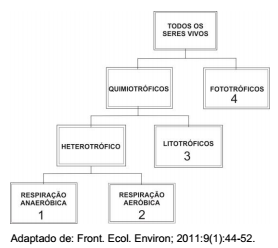
Dengue e tuberculose têm seus principais modos de transmissão representados, respectivamente, em:
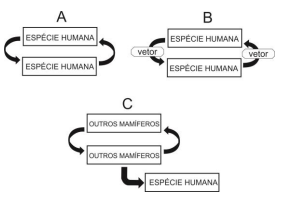
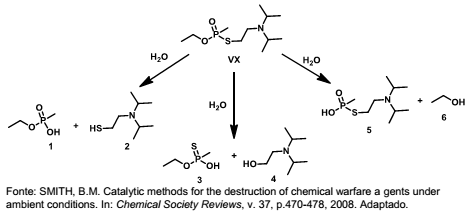
O quadro abaixo mostra as condições para detoxificação do agente VX e respectivos resultados pelos diferentes métodos.

Com base nas informações fornecidas, qual método de detoxificação é mais eficiente?
O ácido carboxílico presente em maior quantidade na amostra analisada é o:
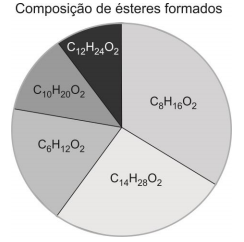

Nesse sistema de medição, faz-se reagir uma amostra contendo glicose com o íon ferricianeto ([Fe(CN)6]3- ) na presença da enzima GOx, obtendo-se como produtos gluconolactona, H+ e ferrocianeto ([Fe(CN)6]4- ). Um eletrodo de platina promove a reação de regeneração do ferricianeto, sendo que a corrente que passa por esse eletrodo é proporcional à concentração de glicose na amostra.
Com base no exposto, identifique como verdadeiras (V) ou falsas (F) as seguintes afirmativas:
( ) A enzima GOx catalisa a oxidação da glicose.
( ) No eletrodo de platina ocorre a redução do íon de ferro.
( ) A transformação de glicose em gluconolactona envolve 2 elétrons.
( ) O valor de pH do meio tende a diminuir no processo de detecção de glicose.
Assinale a alternativa que apresenta a sequência correta, de cima para baixo.
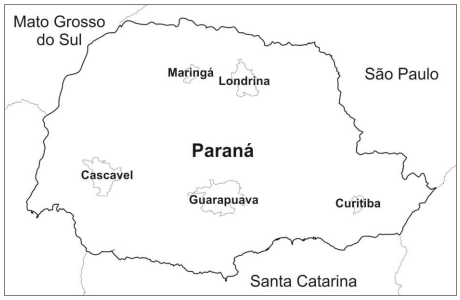
Sabendo-se a coordenada de um ponto localizado no centro do município de Curitiba (Latitude: 25,47º S e Longitude: 49,28º W.Gr.), identifique as coordenadas do centro dos demais municípios em destaque:
(INCRA-PR. Relatório Conflitos Fundiários Rurais no Estado do Paraná. Abril 2015.)
Considerando as informações do texto e os conhecimentos sobre a questão fundiária brasileira, assinale a alternativa correta.
Brasil: distribuição dos municípios por níveis de centralidade, 2014.
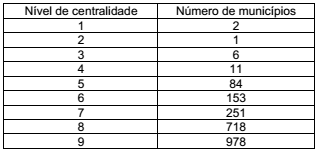
(Fonte: IBGE, 2014. Disponível:<ftp://geoftp.ibge.gov.br/redes_e_fluxos_do_territorio/gestao_do_territorio/gestao_do_territorio_2014.pdf> . Acesso em 17 set. 2015)
Considerando os conhecimentos de geografia urbana e sabendo que no nível 1 de centralidade de gestão encontram-se São Paulo e Brasília; no 2, Rio de Janeiro; e no 3, Porto Alegre, Curitiba, Belo Horizonte, Salvador, Recife e Fortaleza, assinale a alternativa correta.
(LEITE, Marcelo. Disponível em:<http://www1.folha.uol.com.br/colunas/marceloleite/2015/09/1678431-dois-portugais-de- floresta-perdida.sht ml>. . Acessado em 29 set. 2015)
Considerando as informações do texto e os conhecimentos de geografia, assinale a alternativa correta.
Sobre os processos geomorfológicos que têm sido intensificados pela influência humana, considere as seguintes afirmativas:
1. O processo de assoreamento tem ocorrido com grande frequência nas áreas mais elevadas do relevo, onde as declividades são mais íngremes, trazendo prejuízos por afetar os chamados topos de morros.
2. Os escorregamentos e as corridas de detritos e lama, que são deflagrados por grande volume de chuvas e ocorrem, predominantemente, em regiões serranas e nas encostas com maiores inclinações, estão entre os processos geomorfológicos que trazem maiores danos à sociedade.
3. A erosão pluvial em vertentes, que traz grandes prejuízos econômicos e ambientais, está condicionada, além de às características do relevo, também aos tipos de solo, à dinâmica das chuvas, à cobertura da vegetação e ao tipo de uso antrópico.
Assinale a alternativa correta.